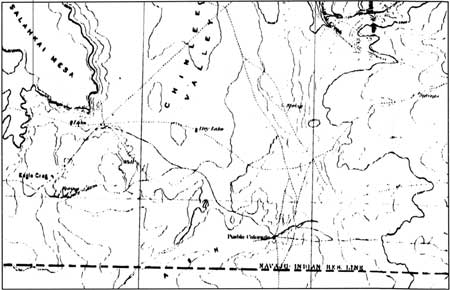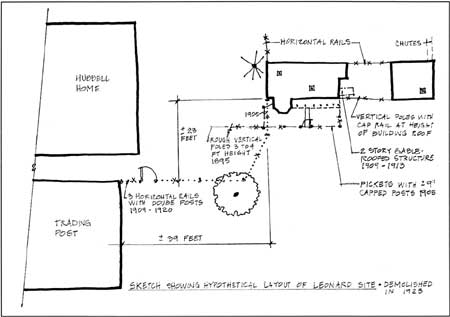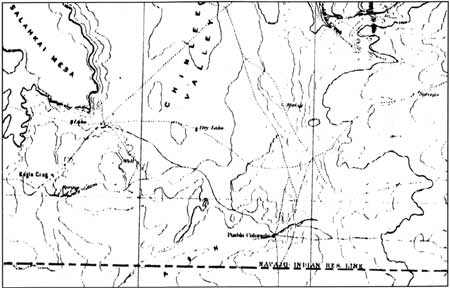|
Hubbell Trading Post
Cultural Landscape Report |

|
SITE HISTORY (continued)
CULTURAL LANDSCAPE HISTORY OF THE HUBBELL TRADING POST AND HOMESTEAD
Early Settlement
Although the landscape associated with the Hubbell Trading Post has undoubtedly undergone some substantial changes over the last several thousand years with regard to climate and vegetation, the perennial flow of the waters in the Pueblo Colorado Wash has served to attract both man and beast and encourage human settlement. Within the boundaries of the Hubbell Trading Post National Historic Site, approximately twelve prehistoric archeological sites have been identified. At the present time there have been no Paleo-Indian period (ca. 9500 B.C. - 5500 B.C.) or Desert Culture period (5500 B.C. - 0 A.D.) sites located within the park boundary, however sites from both of these cultural periods have been located in the surrounding region.
Numerous Anasazi period (A.D. 0 - A.D. 1540) sites have been located within the boundaries of the park and range from Basketmaker II (A.D. 1 - A.D. 500) through Pueblo III (A.D. 1100 - A.D. 1300). For more information regarding these sites the reader is referred to the National Register of Historic Places Nomination Form — Hubbell Trading Post National Historic Site, Ganado, Arizona. The locations of identified prehistoric archeological sites are not included in this report due to the need for confidentiality.
Several early or historic period Navajo (A.D. 1540 - present) sites have also been located within the park boundaries. Through archeological excavations and testing projects the locations of two hogans (possibly dating from the mid-eighteenth century) and numerous associated features including corrals, pens, hearths, and ramadas have been identified. The possible site of an early twentieth century hogan was also located by the Chaco Center Remote Sensing Team. Locations for these early Navajo sites are included on the site base map included in this report.
Sometime around 1874 or 1875 a trader named William Leonard came down from Fort Defiance and established a trading post operation on the banks of the Pueblo Colorado Wash at the present site of the Hubbell Trading Post. The trading post and its associated Navajo community was known as Pueblo Colorado (Red Town). The name was taken from a nearby pueblo ruin called kin dah Lichi'i (Red House in the Distance). [67] While some early maps of the area refer to Pueblo Colorado (figure 13), the name was changed in the late nineteenth century about the time the first post office was established to avoid confusion with the town of Pueblo, Colorado. The community's name was changed to Ganado in honor of Ganado Mucho, the last peace chief of the Navajos. [68] Leonard apparently recognized the potential of the site with its perennial water flow, its close proximity to nearby Fort Defiance, and its location on one of the few east-west wagon routes through the area. No additional information has been located regarding this early period of site development.

|
| Figure 13. United States Geological Survey topographic map, 1892 Ft. Defiance, 1:25,000 showing Pueblo Colorado, which was later renamed Ganado. (click on image for an enlargement in a new window) |

|
| Figure 14. Old Leonard Trading Post following Hubbell's acquisition of the property. (HUTR 2122). |
Expansion and Development of the Ganado Trading Post (1878-1894)
In 1876 John Lorenzo Hubbell relocated from Fort Defiance and built himself a small stone and log trading post in the immediate vicinity of what is now Ganado Lake. Hubbell had worked as a clerk in several trading posts throughout the Utah and Arizona territories and also served as an interpreter and sutler's clerk at nearby Fort Defiance. By 1878 John Lorenzo Hubbell purchased the William Leonard trading post and within a few years he had begun to expand and develop the trading post operation and its adjacent lands (figure 14). Hubbell originally utilized the roughly constructed Leonard buildings. In his "Homestead Proof — Testimony of Claimant" [69] Hubbell states:
My house was built on the land about July 1878; and established actual residence therein at the same time; improvements consist of dwelling house 12 rooms; store building, warehouse, stable, blacksmith shop, fencing, etc. value about $5000.

|
| Figure 15. The Leonard Buildings 1895. Photograph taken by Ben Wittick. (HUTR 8632). |
Early photographs of the trading post show quite an extensive complex of structures and enclosed spaces and based on the above reference it might be inferred that the majority of the development was constructed by J.L. Hubbell following his acquisition of the operation from Leonard (figure 15). While an 1869 map accompanying the Annual Report of the Commissioner of the General Land Office and a later 1879 map by the Rand McNally Co. identify Pueblo Colorado, Arizona and some nearby trails, mines, and springs neither includes structural developments or buildings. The same is true of an 1882 U.S. Geological Survey Topographic Quadrangle map that shows the community of Pueblo Colorado, Arizona and a few unimproved roads. However, it does not depict individual structures or areas of development (figure 16). It is historic photographs taken during the 1890s and early 1900s that provide us with glimpses of the original Leonard complex following Hubbell's occupation of the site (refer to figures 14 and 15). It has been hypothesized that the northernmost building within this complex was the original Leonard building and that the buildings to the south were constructed by J.L. Hubbell. However, any changes or modifications made to the original Leonard design and layout by J.L. Hubbell have not been confirmed through documentation. Archeological investigations of this significant area within the Hubbell landscape may provide valuable information regarding the building chronology of the original trading post complex. Using available archeological data and the available historic photographs a sketch of the potential layout or footprint of the Leonard/Hubbell trading post site has been prepared (figure 17).

|
| Figure 17. Hypothetical schematic layout of early Trading Post buildings, Leonard/Hubbell Trading Post. (click on image for a enlargement in a new window) |
Available information regarding the development history of the site reveals that in addition to Hubbell's modifications to the old Leonard buildings he initiated construction of the office and rug room sections of the existing post as early as 1883. [70] One of the many depositions attached to Hubbell's Homestead Application states that E.S. Clark visited the Ganado tract in 1882 and improvements had been made "including dwelling house, store building, warehouse, stable, wells, enclosures and other improvements of a substantial nature..." [71] It is unclear as to whether the improvements mentioned are all in the immediate vicinity of the Leonard post or if the warehouse and enclosures mentioned might be new and separate developments.
While J. L. Hubbell started his business at Pueblo Colorado, Arizona as the sole owner of the trading post operation, documentation reveals that in 1884 he brought in partners one of whom was a Mr. C.N. Cotton to assist with the trading post. By 1885 the entire business was under the sole ownership of Mr. Cotton as is evidenced by two letters written on June 22nd, 1885 by J.L. Hubbell that state "I have this day sold out my interest in the Pueblo Colorado store to C.N. Cotton..." [72] It seems that any improvements made to the property during the years 1885 to 1894 were undertaken by Cotton as he remained in residence at the Ganado store while Hubbell served as sheriff of nearby St. Johns (1882-1886) and the Hubbell family took up residence in a variety of towns including St. Johns, Arizona and Albuquerque and Gallup, New Mexico. Hubbell's involvement with the trading post operation at this time, if any, has not been determined.
During the period 1885 to about 1894 all correspondence from the Pueblo Colorado trading post operation in Ganado was prepared with Cotton's signature and many of the letters were prepared on Cotton's business letterhead (figure 18). A review of the trading post's correspondence files reveal that Cotton was not only struggling to retain the homestead before the lands were officially surveyed by the government but he also addressed the need to get irrigable waters to the site. Although Hubbell immediately began making improvements to the property following his acquisition of the post in 1878 and seemed intent on filing a land claim, the 1880 boundary expansion of the Navajo Reservation was drawn to include the 160 acre tract surrounding the trading post. According to Peterson, Hubbell and Cotton joined forces in August of 1890 and appealed to the Commissioner of Indian Affairs to have "Cotton's homestead excepted from the executive order of 1880, which had extended the reservation to include their trading post." [73] Cotton then wrote other letters to Washington and was notified that the "executive order was within legal rights and that it made no exception from the withdrawal from sale and settlement of tracts settled upon or occupied prior to 1880." [74] The response also noted that "since the land had been unsurveyed Cotton had acquired no vested right to it." [75] Little else was done until the end of the decade regarding actions to secure title to the land although Cotton expressed his frustrations in a letter he addressed to the Honorable C.E Vandever, U.S. Indian Agent, in which he states that he "had hopes that the Indian department would consider my case, and not compel me to take out a license as my ranch was taken up or located about the same time that Mr. Keams located at Keam's canon which at that time was not on the Navajo Reservation. But since that time the Reservation has been extended taking up both places." [76]

|
| Figure 18. Letterhead used by C.N. Cotton while operating the Trading Post. |
A separate letter was prepared by Cotton on April 5th, 1889 and mailed to the Honorable Commissioner of Indian Affairs. He references early letters that explain how he is situated at Pueblo Colorado and then "most respectfully" asks for a license to trade at Pueblo Colorado. [77] A letter written by Cotton a few days later includes one of the earliest known references to the proposed diversion of waters from Pueblo Colorado Creek. Cotton states:
perhaps Mr. Marshall considered I was meddling with your business when I suggested that the Pueblo Colorado Creek would be a good place for you to put up a dam. And I also remarked that Chin I lee (sic) was too sandy to make a permanent dam. I said this and don't deny it. And cannot see that I could possibly injure anyone by making such a statement. I do not know of any plot or scheme to your detriment. Nor would I consider such a thing. If I've got any complaint to make I'll come to you personally and make it. [78]
While historic photographs and documentation sources reveal that some improvements were made to the property during Cotton's ownership and management period, it appears that the major developmental period began after Hubbell regained ownership of the property. It appears that Cotton possibly undertook fencing of sections of the property, possibly to contain some of his livestock including cattle, horses, and sheep. In a letter dated October 1885 Cotton places an order for miscellaneous items that includes "1 wire stretcher for putting up wire fence". [79] About this same time there are several letters referencing his purchase of work cattle, Jersey cows, and other stock as well as orders for a variety of magazines and periodicals such as Country Gentleman, American Sheep Breeder, Harpers, and Arthurs Home Magazine.
Based on tree-ring information, the roof of the trading post's office and rug room originally constructed in 1883 was replaced in 1889 and "the store and wareroom were added...bringing the present structure to its existing floor plan." [80] Construction began on the core section of the barn sometime around 1893 and this single story block was probably completed in 1895. [81] No additional information has been located regarding the historic landscape and additional site improvements or developments for this early period. According to Hubbell's granddaughter LaCharles Eckel, J.L. Hubbell's partnership with C.N. Cotton was dissolved in 1894 and Cotton moved to Gallup to take over the wholesale business which had been established. [82]
| <<< Previous | <<< Contents >>> | Next >>> |
hutr/clr/clr2b.htm
Last Updated: 26-Apr-2004
